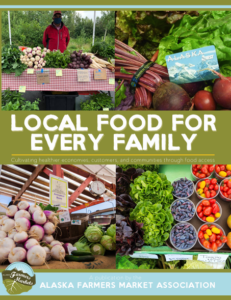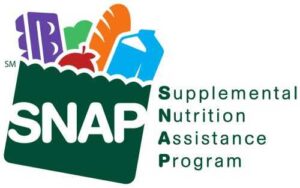Equity Programs
Information can be found here: Local Food For Every Family
“Every Alaskan deserves to participate in their food system by purchasing fresh, local produce. Unfortunately, the reality is that many of our neighbors struggle to put healthy meals on the table for themselves and their families. About 80,000 Alaskans are facing food insecurity in Alaska, meaning their access to adequate food is limited by a lack of money and other resources. For the roughly 112,000 Alaskans who receive food assistance, shopping at a farmers’ market has historically not been the most cost-effective way to ensure they can fill their fridges and pantries.
The Alaska Farmers Market Association (AFMA) believes that we all have a role to play in ensuring local food is accessible to marginalized and underserved communities. Our hope is that this toolkit helps farmers, vendors, market managers, and other stakeholders understand how they can contribute to a more equitable food system. By accepting payment from food assistance programs, markets can play a critical part in making community members from all income levels feel welcomed and included. Clients are able to purchase high-quality, local fruits and vegetables while stimulating the local economy with federal dollars. More Alaskans can build community connections by shopping at a farmers’ market and getting to know the people that grow, raise, and catch their food.”

Ensuring local foods are accessible to all Alaskans is a priority of most, if not all, Alaska Food Hubs.
Here are some programs to consider with an equity lens:
SNAP (Supplemental Nutrition Assistance Program):

Food hubs nationwide have been piloting online SNAP/WIC or EBT usage with the Federal Nutrition Service (FNS). While no food hubs in Alaska currently have this capability, we remain optimistic about accepting EBT in the future. It is a prime area to focus our efforts as a group to positively impact both farmers and those who benefit from these programs.
Notably, one New York food hub is offering online sales with reported EBT online functionality. However, obtaining an FNS number remains the primary hurdle for most food hubs. FNS regulations haven’t fully addressed the unique structure of food hubs, which differ from both farmers markets and traditional brick-and-mortar stores, creating a gray area that currently hinders application approvals.
WIC (Women Infants & Children)

The WIC program aims to safeguard the health of low-income women, infants, and children up to age 5 who are at nutrition risk by providing nutritious foods to supplement diets, information on healthy eating, and referrals to health care.
State of Alaska: WIC Program Office
Phone: 907-465-3100
Email: wic@alaska.gov
More information at: Alaska Division of Public Assistance
Grants for starting a food hub:
Local Food Promotion Grant
Almost every Alaskan food hub utilized an awarded grant from the Local Food Promotion Program (LFPP) to fund the development food hubs.
“The Local Food Promotion Program (LFPP) funds projects that develop, coordinate and expand local and regional food business enterprises that engage as intermediaries in indirect producer-to-consumer marketing to help increase access to and availability of locally and regionally produced agricultural products. Grants can be used for the planning stages of establishing or expanding a local and regional food business enterprise or to improve or expand a food business that supports locally and regionally produced agricultural products and food system infrastructure by performing feasibility studies, market research, training and technical assistance for the business enterprise and/or for producers working with the business enterprise. A 25% match is required.”
Local Food Purchase Assistance Cooperative Agreement Program (LFPA)
Local Food Purchase Assistance Cooperative Agreement Program (LFPA) uses non-competitive cooperative agreements to provide up to $900 million of American Rescue Plan (ARP) and Commodity Credit Corporation (CCC) funding for state, tribal, and territorial governments to purchase foods produced within the state or within 400 miles of the delivery destination to help support local, regional and underserved producers. The purpose of this program is to maintain and improve food and agricultural supply chain resiliency. The cooperative agreements allow the states, tribes and territories to procure and distribute local and regional foods and beverages that are healthy, nutritious, unique to their geographic areas, and that meet the needs of the population. The food will serve feeding programs, including food banks, schools, and organizations that reach underserved communities. In addition to increasing local food consumption, the funds will help build and expand economic opportunities for local and underserved producers.
Some of the food hubs in Alaska utilize this program to help purchase locally grown and produced foods from farmers in Alaska. For example, the Qik’rtaq Food Hub, which includes six geographically isolated villages and Steven’s Village tribal buffalo ranch, will use these funds to support the growth of regional farming through pilot programs to provide distribution to small villages and tribes in their areas. LFPA partners local farmers, village and tribal farms, and ranches with local distribution to those in their communities that do not geographically or financially have access to local fresh foods.
Resilient Food Systems Infrastructure (RFSI)
The purpose of the Resilient Food Systems Infrastructure (RFSI) program is to build resilience in the middle of the food supply chain, to provide more and better markets to small farms and food businesses, to support the development of value-added products for consumers, fair prices, fair wages, and new and safe job opportunities. RFSI provides up to $420 million of American Rescue Plan (ARP) funding to the agency, commission, or department responsible for agriculture within the 50 States, the District of Columbia, the Commonwealth of Puerto Rico, Guam, American Samoa, the U.S. Virgin Islands, and the Commonwealth of the Northern Mariana Islands.
States and territories will work in partnership with USDA to make competitive subawards to support infrastructure in the middle of the supply chain for domestic food and farm businesses and other eligible entities. States and territories may use a limited portion of funds to develop and/or strengthen supply chain coordination and targeted market development services for local and regional products.
Specialty Crop Block Grant
The purpose of the Specialty Crop Block Grant Program (SCBGP) is to enhance the competitiveness of specialty crops. Specialty crops are defined as “fruits, vegetables, tree nuts, dried fruits, horticulture, and nursery crops (including floriculture).”
The U.S. Department of Agriculture (USDA) Agricultural Marketing Service (AMS) distributes block grant funds annually, which are administered by State departments/ divisions of agriculture to enhance the competitiveness of specialty crops. The Specialty Crop Block Grant Program (SCBG) seeks to increase production, consumption, access, knowledge, and sustainability of Alaska Grown specialty crops, sustain farmers’ livelihoods, and strengthen local communities. Each year, the Alaska Division of Agriculture receives approximately $250,000 from USDA for this program to distribute through competitive grants. Potential grant recipients might include a group of professional producers, universities, extension services, soil and water conservation districts, or schools working in cooperation with a business or non- profit. The maximum award amount for this grant is $60,000. The grant performance period for this grant is up to 3 years.